At Io, the scientifically most useful type of mutual event have been occultations. By monitoring the brightness of Io as another moon occults it, an astronomer can determine the location of hotspots on the surface by measuring the time when bright IR sources are occulted then later reappear. Robert Howell measured quite a few of these occultations during prior mutual event seasons in 1996-1997 and 2003. See his LPSC abstract from 2003 for an overview. Using these occultations, Howell could not only determine whether or not Loki was active, for example, but also which part of its patera was hot. Recent developments in adaptive optics technology have greatly improved the spatial resolution of ground-based observations, seemingly reducing the need for making such measurements now that they rival them in resolution. However, these adaptive optics observations are only performed at a few of the largest telescopes in the world, like Keck and ESO, which may observe at best a few nights out of the year. Occultation measurments can be acquired by much smaller telescopes equipped with a high-speed, infrared photometer.
The only potential barrier to the events being observed next year is that Saturn will be undergoing a similar ring-plane crossing at about the same time. With a larger orbit, Saturnian equinoxes happen more rarely, every 15 years as opposed to every 6 years for Jupiter. With Cassini in orbit around Saturn making concurrent observations, this ring-plane crossing has even more importance. Therefore, Jupiter's mutual event season may take a lesser priority for astronomers worldwide. [NOTE: After publishing this post, I saw a NASA press release mentioning that Saturn's ring plane crossing will occur as Saturn nears conjunction, when Saturn will be near the sun. So maybe Jupiter's mutual events won't take as much of a backseat since so many of the "good" events occur around opposition, when Jupiter will be opposite the sun in the sky.]
In addition to equinoxes, Io will experience eclipses of the Sun by two other Galilean satellites: Ganymede and Callisto. All but two of the total eclipses seen from Io will be by Ganymede. Ganymede eclipses occur a week, beginning on June 9 and ending on August 5. The early eclipses are best seen in the north polar region, while the later eclipses are best seen over the south polar region.
Here is an overview of the most interesting eclipses:
 The eclipse covering the most terrain on Io will be the total solar eclipse by Ganymede on July 15, 2009 at 10:47 UTC. The total solar eclipse will be visible across much of Io's sub-Jupiter hemisphere between 48 North and South latitude, and 232-52 West longitude. The polar regions will experience a partial eclipse. During the eclipse, Ganymede will appear 13' 17.2'' across in the sky (compared to our moon, which appears around 30' across in Earth's sky). The sun will appear 6' 19.9". Therefore, it is unlikely that the sun's corona would be seen during the eclipse except near the beginning and end. At its peak, the eclipse will last 1 minute and 55 seconds long.
The eclipse covering the most terrain on Io will be the total solar eclipse by Ganymede on July 15, 2009 at 10:47 UTC. The total solar eclipse will be visible across much of Io's sub-Jupiter hemisphere between 48 North and South latitude, and 232-52 West longitude. The polar regions will experience a partial eclipse. During the eclipse, Ganymede will appear 13' 17.2'' across in the sky (compared to our moon, which appears around 30' across in Earth's sky). The sun will appear 6' 19.9". Therefore, it is unlikely that the sun's corona would be seen during the eclipse except near the beginning and end. At its peak, the eclipse will last 1 minute and 55 seconds long. The only total solar eclipses by Callisto visible from Io will both occur on June 20, 2009. These eclipses will primarily be visible in the south polar region of Io, on the trailing hemisphere side. The first eclipse occurs at 04:32 UTC, while the second occurs at 09:01 UTC. A third total eclipse would be visible on June 3, however totality starts after a Jovian eclipse has started. June will also see two, multiple Ganymede eclipse days, with two eclipses on June 9 and three on June 16.
The only total solar eclipses by Callisto visible from Io will both occur on June 20, 2009. These eclipses will primarily be visible in the south polar region of Io, on the trailing hemisphere side. The first eclipse occurs at 04:32 UTC, while the second occurs at 09:01 UTC. A third total eclipse would be visible on June 3, however totality starts after a Jovian eclipse has started. June will also see two, multiple Ganymede eclipse days, with two eclipses on June 9 and three on June 16.

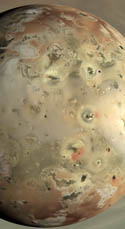



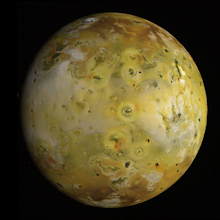

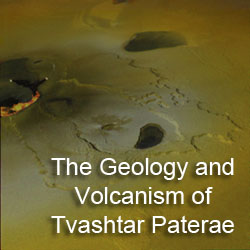
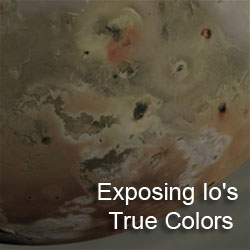
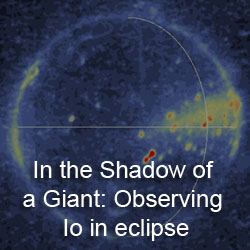
Interesting post. I've been looking a lot at the mutual events in the Saturnian system lately, and I was unaware that we'd be seeing eclipses in the Jovian system as well. I just checked in a fix to Celestia that gives more accurate renderings of eclipse shadows in the advanced (OpenGL 2.0) render path. The improvements are most dramatic in events where the occulter appears smaller than the Sun. This is the typical situation with mutual events in the Saturn system, so make sure you get the patch before investigating these. The improvement won't be as dramatic for the Galileans.
ReplyDeleteJust upgraded to build 4585 with the new eclipse code. It looks great for the Saturnian system and eclipse events in the Jovian system involving the smaller, inner moons. The eclipses involving the Galileans appear the same.
ReplyDelete